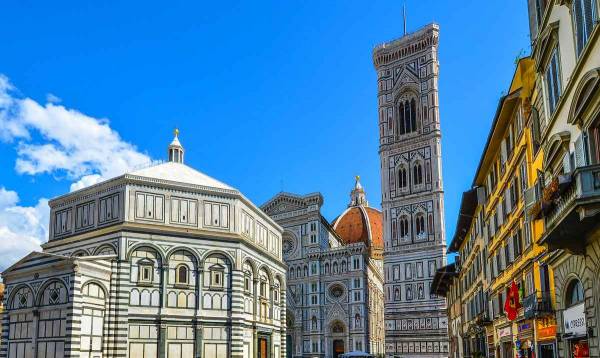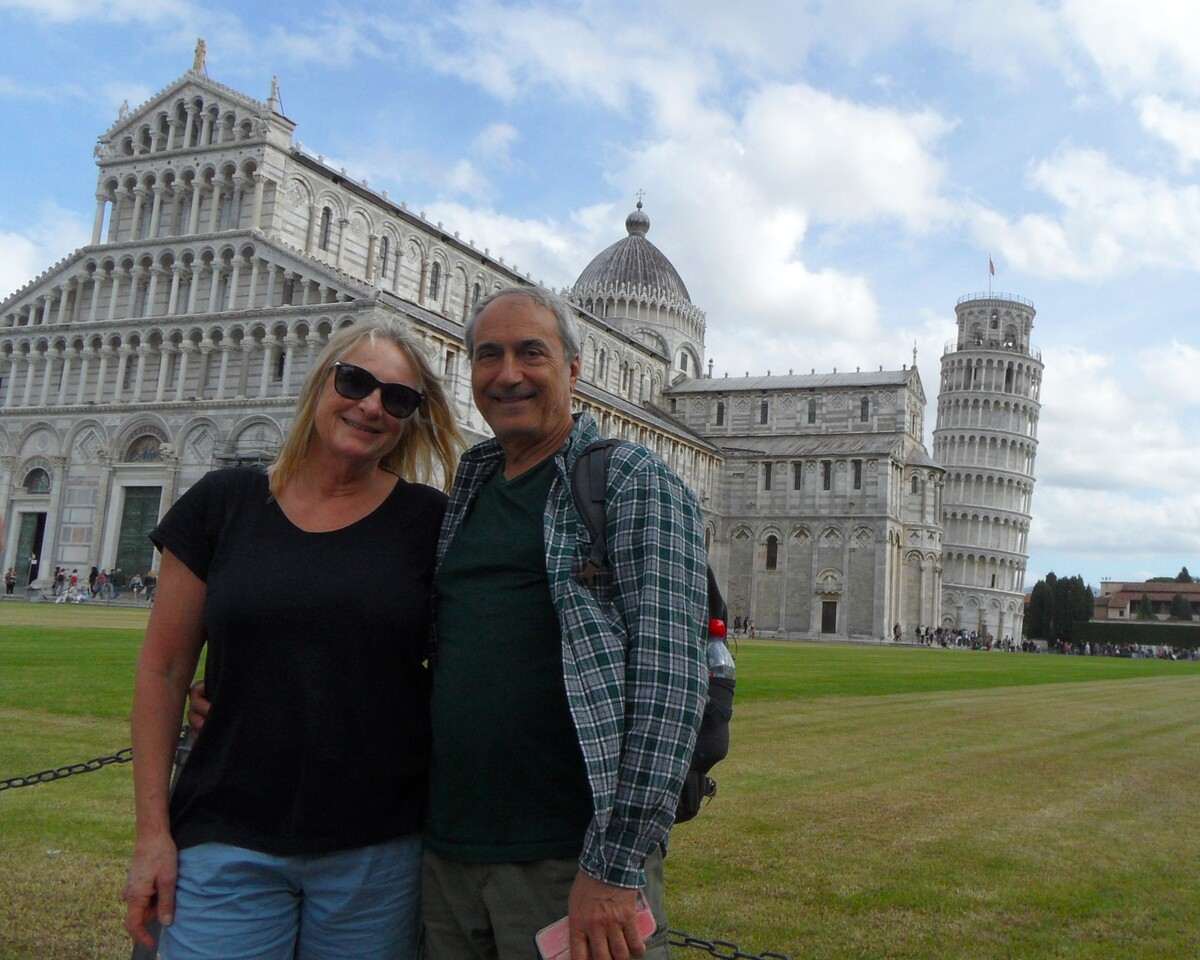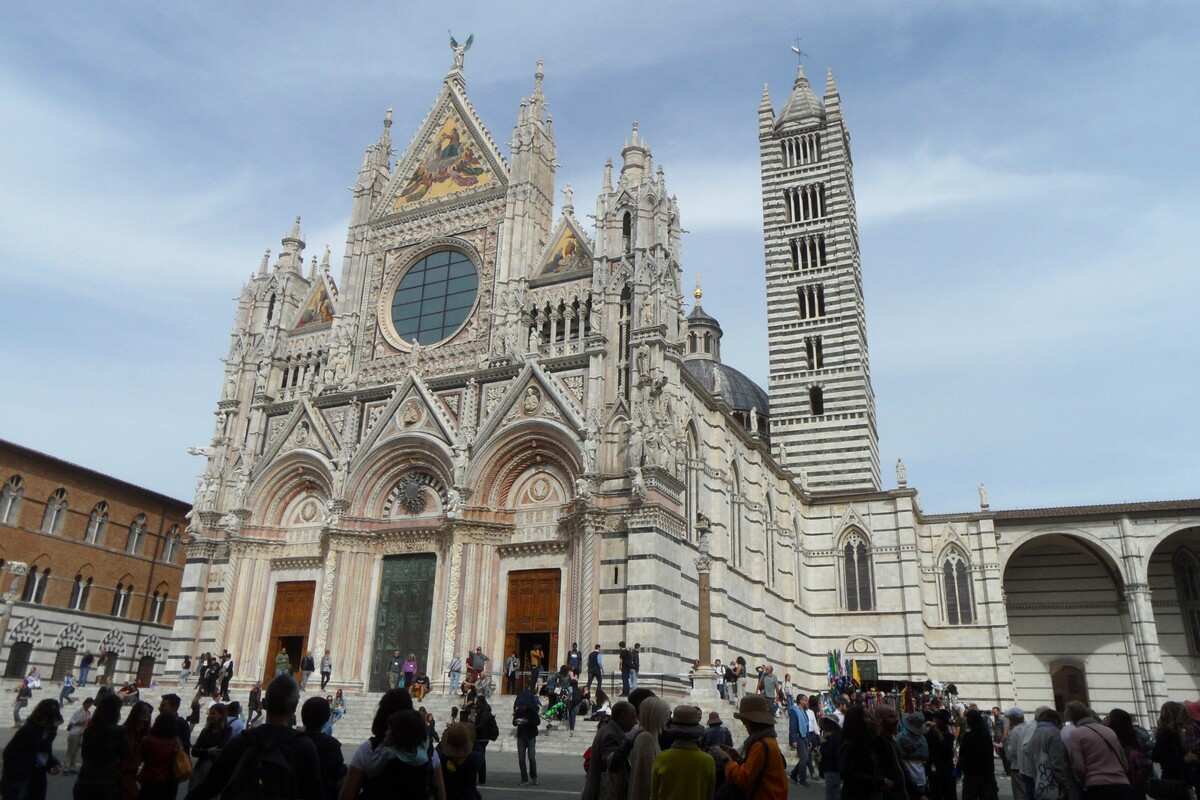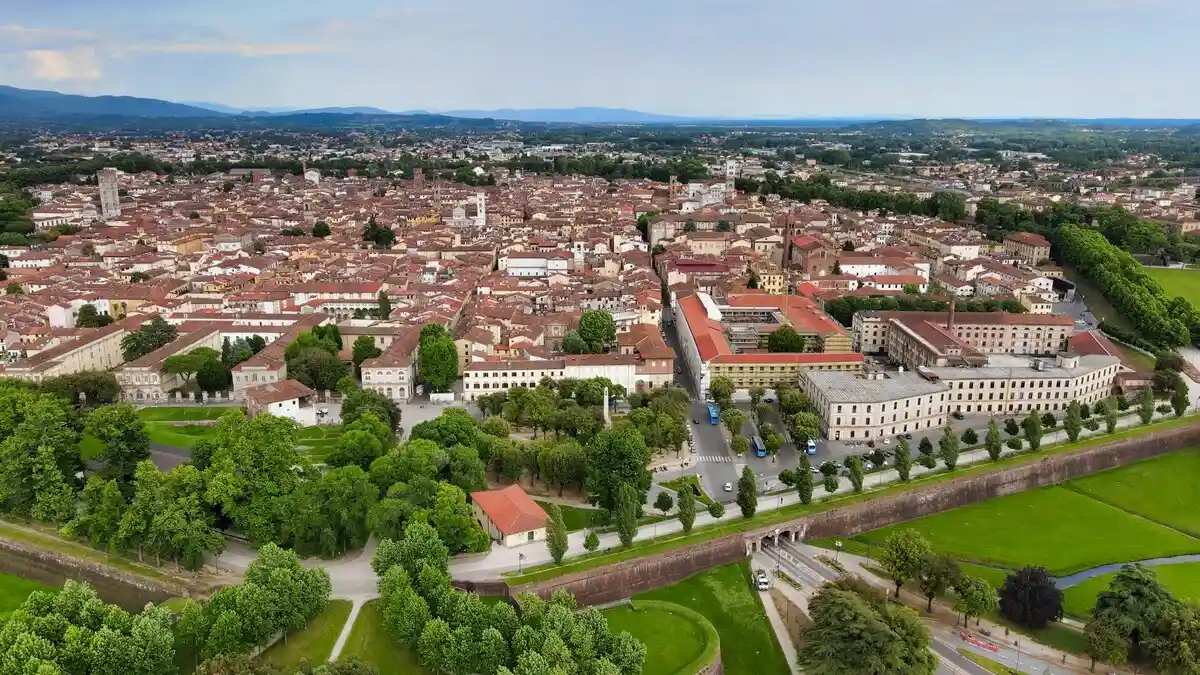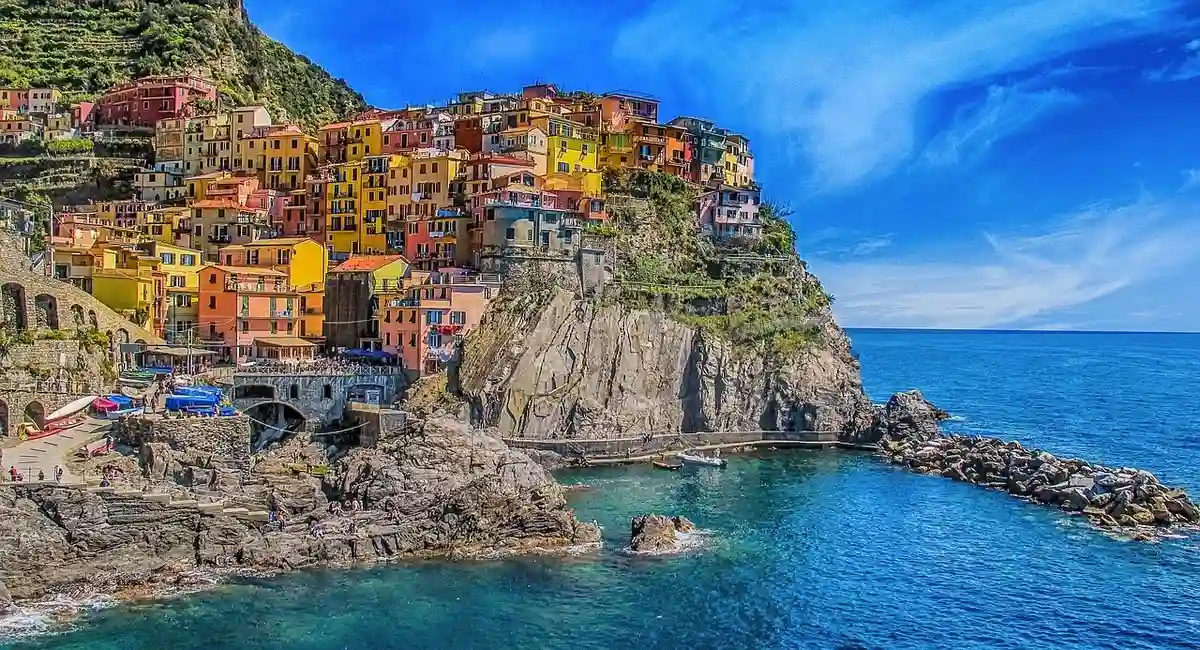If this is your first visit to Italy’s capital city, trying to see Rome in 1 day may sound complicated but with a little planning it’s easy to do. The historic centre of Rome is walkable, and the Rome Metro is efficient and cheap, so getting around is quite simple.
The Vatican IS a separate country in its own right but practically part of Rome and a visa is not required.
While you need at least 3 days to see Rome in more depth, the most iconic sites like the Colosseum and Vatican City can be enjoyed on a 1-day trip. Just keep within a set time-frame, and avoid the temptation to wander the side streets!
From personal experience, I’ve put together this easy to follow 1-day Rome itinerary which includes a map and useful tips on how to see Rome and the Vatican in a day.
Staying in Rome for 2 nights is the best plan as this gives you a full day of sightseeing and the evenings to enjoy some local cuisine.
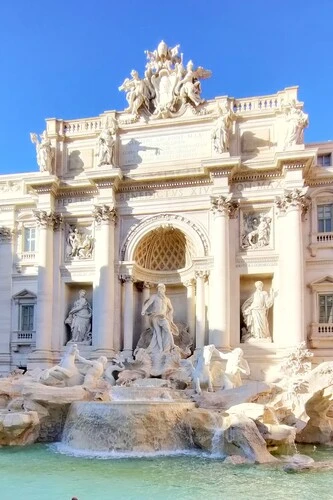
1 DAY IN ROME ITINERARY
- 1. Visit the Colosseum
- 2. Admire the views from Palatine Hill
- 3. Wander around the Roman Forum
- 4. Head towards Trevi Fountain
- 5. Walk over to the Spanish Steps
- 6. Get the Metro to the Vatican City
- 7. Enter St Peter’s Basilica
- 8. See the Tiber River bridges
- 9. Watch the sunset over Castel Sant Angelo
- 10. Dine in Piazza Navona
PLANNING A TRIP TO ITALY?
SEE OUR HELPFUL GUIDES TO: *Florence *Pisa *Siena *Lucca *Venice *Bologna *Cinque Terre
How To See Rome In A Day
Text and original photos by Kali Marco.
Rome is one of the most historical cities on Earth, the Colosseum is a Wonder of The World, and the Vatican City a major World Heritage Site. Ancient Roman ruins, and some of Italy’s top museums, lie within the old quarters. Streets lined by elite stores and little Italian restaurants, conceal squares full of historic treasures. River Tiber divides this Centro Storico from the Vatican State.
How the heck can you see all this in only 1 day? First plan and prioritise what you want to do.
Ideally, plan your day in Rome for spring or autumn when the weather is mild and daylight hours are longer. To beat the crowds, choose a weekday and avoid peak seasons such as Easter or Christmas.
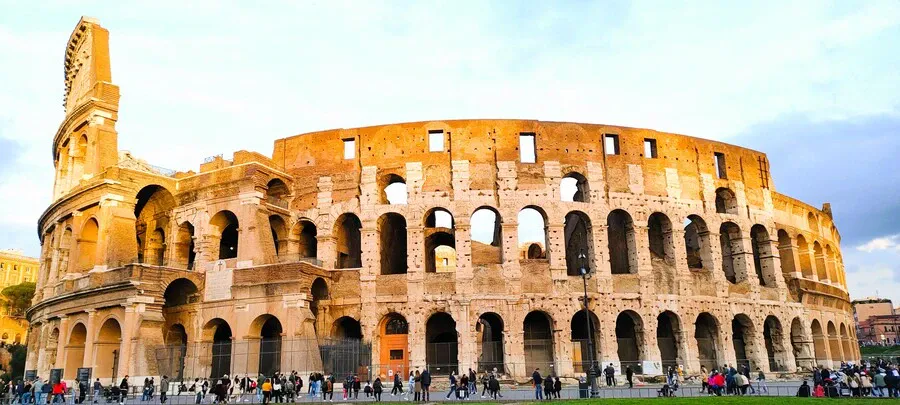
Rome is the ideal place to start or end a trip through Italy as FCO airport is an international hub. It takes 30 minutes to get into the heart of the city on the Leonardo Express shuttle. If you’re on a long layover between connecting flights, it’s simple to come in for the day.
Visiting Rome and the Vatican as a day out from other Italian destinations is easiest by train or bus as driving (and parking) in the city centre is strictly limited. Cruises dock at Civitavecchia (about an hour away), where you can either join an organised tour or get into Rome by rail for the day.
If you’re staying overnight in Rome, book accommodation in the Centro Storico (the historic centre), ie near the Pantheon or Trevi Fountain. This neighbourhood is centrally located and full of charm. Although it can be more expensive than places further out, you’re within walking distance of the main sites, so it’s perfect for a 1 or 2-night stay.
Alternatively, look for somewhere to stay close to Roma Termini Station (just a couple of stops away on the Metro from the city centre, this is Rome’s main train terminal with direct fast trains to FCO airport and major cities across the country.
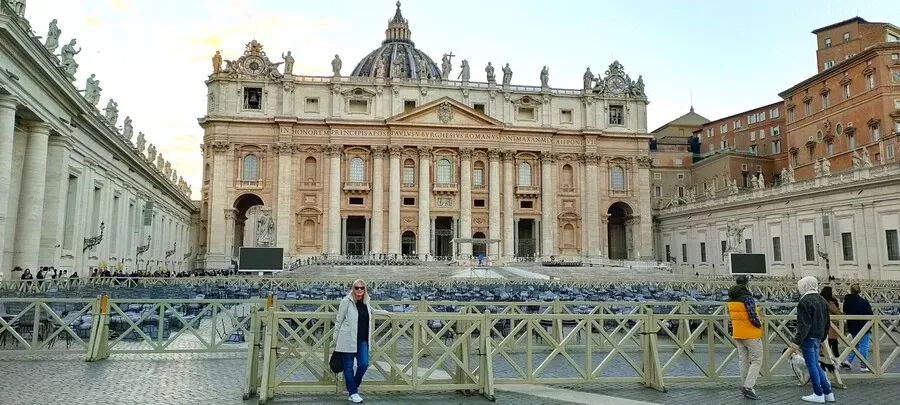
Is seeing the Pope top of your wish list? Then schedule your Rome visit for a Wednesday when there is usually a Papal Audience at 9 in the morning in St Peter’s Square. For this once-in-a-lifetime experience, you’ll need to reverse our itinerary, to start the day early at the Vatican, and then finish with the Colosseum in the afternoon.
Otherwise, I suggest going to the Colosseum first, Rome’s most famous landmark. It’s part of the Colosseum Archaeological Park which encompasses the Roman Forum, Palatine Hill and Circus Maximo.
Rome 1-day itinerary map
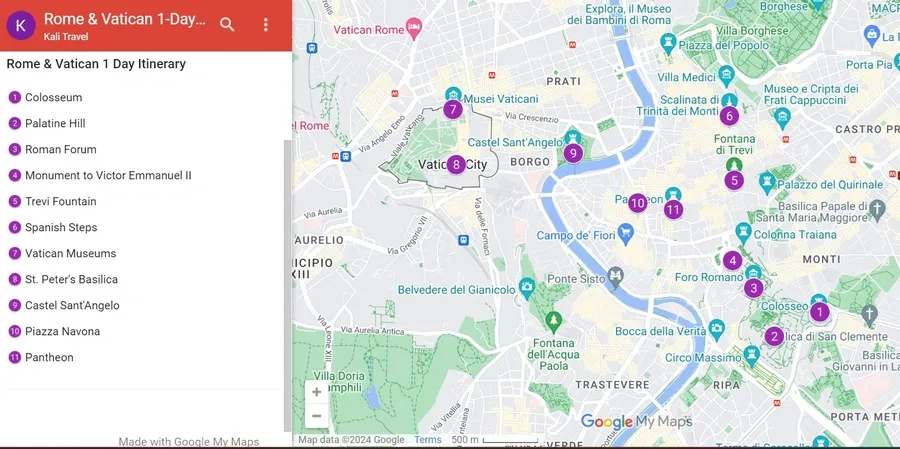
* Click on the image above to see the interactive Google Map of our route. Starting from the Colosseum, through Rome’s historic centre, to the Vatican and back to the Old Quarter, to visit the main sites in a day.
Start your day in Rome with a traditional cornetto pastry (Italian-style croissant in a variety of flavours or fillings… plain, pistachio, custard cream or Nutella), and a caffè macchiato for breakfast. Then you’re good to go!
Tip: Get up at dawn to wander the streets of Rome while it’s quiet, and to take photos of the iconic sites before they’re heaving with tourists.
Visit the Colosseum
Arrive at the Colosseum early to make the best of your day in Rome.
Admittedly, I’ve been fascinated by the Colosseum since I was a small child, inspired by a postcard sent by a great aunt back in the days when only the wealthy travelled abroad. Seen up close in real life, this super famous scene doesn’t disappoint (and I walk past to take more photos every time we go back to the eternal city!).
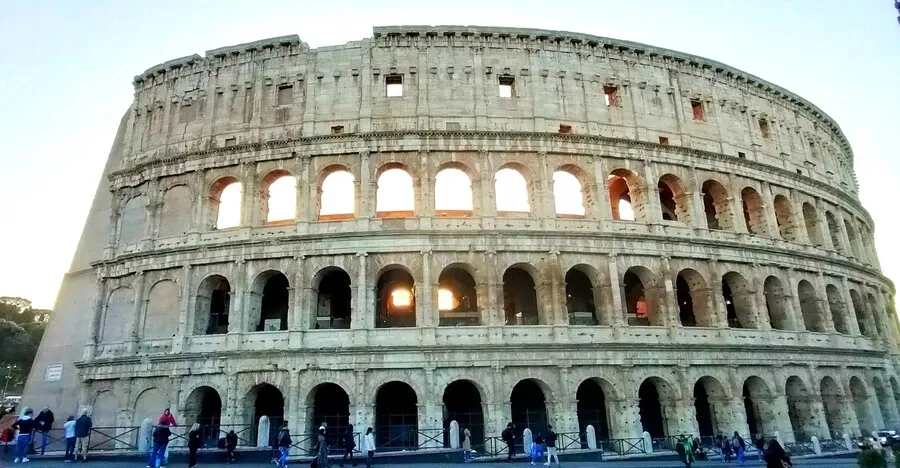
What’s so special about the Colosseum?
Almost 2 millenniums ago, in 80 AD Emperor Titus Caesar Vespasianus completed construction on the Colosseum, a grand-scale project started by his father 8 years previously. It’s still the focal point of Rome today. The biggest amphitheatre in the world, Italy’s most visited tourist attraction draws 10 million visitors annually.
Made of Travertine limestone, strengthened with volcanic rock and finished off with brickwork, the Colosseum has staged Gladiator games, been flooded for mock sea battles, and witnessed the fall of the Roman Empire, lightning strikes, fire, earthquakes and pillaging (in the Middle Ages part of the stonework was cut away). Partially restored in the 18th century, this unique silhouette is THE symbol of Rome.
Inside the Colosseum, the feeling of stepping back in history is just as compelling. From the arched corridor gallery on ground level, you’ll glimpse the oval arena where blood sports and elaborate shows were enacted. This is the 1st Tier where the elite society were seated to watch the entertainment close at hand. You can almost hear the crowds roaring in excitement!
Centuries on, the arena floor is mostly gone revealing the remains of two underground levels, where wild beasts were caged and gladiators entered the enclosure through private tunnels. Although you can tour the ‘hypogeum’ with the ‘Full Experience’ ticket, we wanted to save time and went up directly upstairs on this occasion.
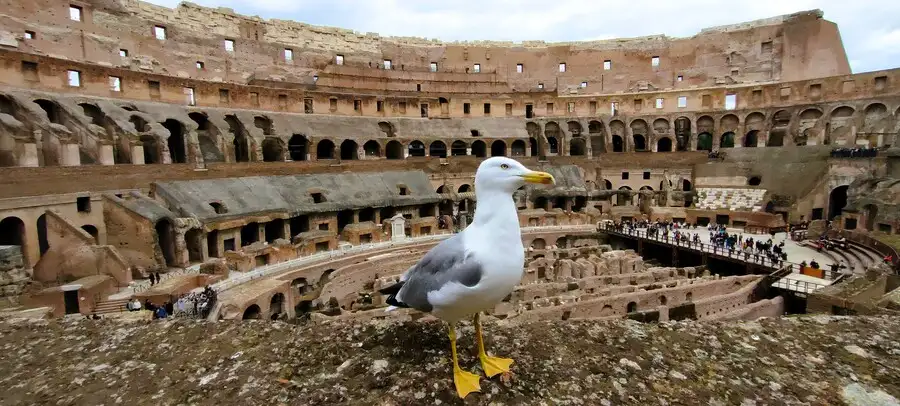
Climb the stone stairs to the 2nd Tier which circles the stadium and you’ll get a bird’s eye view over the arena. This is the upper-class stand where thousands of well-to-do spectators sat (an average of 65,000 Romans attended these spectacles). Fortunately, the Colosseum now has a limit of 3000 visitors a day. This still makes it challenging to get a photo without other tourists in the way!
Finally, the 3rd Tier was reserved for the lower classes (politicians waived fees for ‘commoners’ hoping for their votes). If you want to go up, you’ll need the ‘Full Experience + Upper Level’ entrance pass.
Colosseum Entrance Tickets
Although the Colosseum keeps back entrance tickets so visitors can buy these personally on the day, it’s best to book online from the official site in advance, if you know when you’re coming. This saves queueing. Entrance time is allotted, so choose the earliest slot (around 9 am). Don’t forget to bring your passport which you need to show at the security check.
With the standard Colosseum ticket, you can circle the ground floor of the amphitheatre and go up to the 2nd Tier, which looks onto the arena below where gladiators of the Roman Empire once fought. This is what we did, it’s the best option if you’re short of time, reasonably priced, and a truly atmospheric experience.
If you want to dive deeper into the Colosseum, there are 3 other passes to choose from:
* The ‘Full Experience + Arena’ allows you into the Colosseum Arena Stage as well;
* With the ‘Full Experience + Underground’ you’ll be able to see the level underneath the arena too;
* Additionally, the ‘Full Experience + Upper Level ‘ ticket give access to the Colosseum’s Third Level Tier.
All Colosseum admission tickets include free entrance to Palatine Hill and the Roman Forum (there’s a separate queue on one side of Piazza Colosseo on the path that leads up to this fascinating part of ancient Rome). This is a large site with numerous points of interest and you could spend ages wandering about. Still, it’s worth spending an hour or so here on your day trip, as well as entering the Colosseum.
However, if you’re only in Rome for a few hours, you can admire the Colosseum from the outside, and look over the ruins of the Roman Forum from Via dei Fori Imperiali. And you’ll still capture those iconic photos to remember the day!
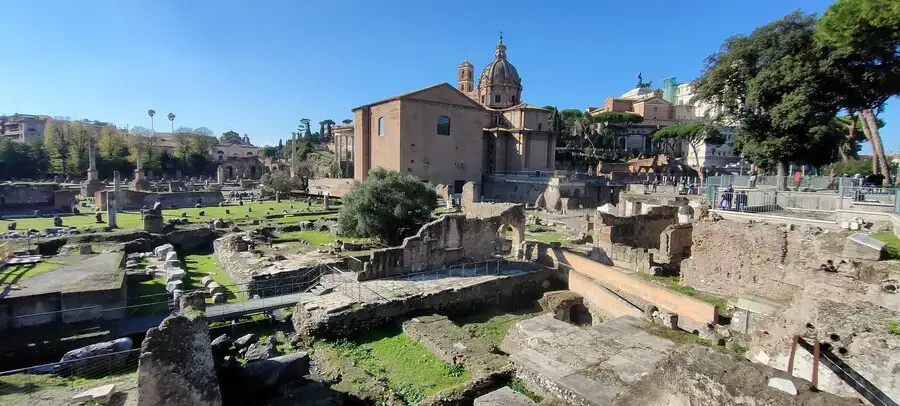
How to Get to The Colosseum
The Colosseum is on the edge of Rome’s ‘Centro Storico’ old town centre, and a 20-minute walk from Trevi Fountain, for example.
Nearest Metro Station: Colosseum on the Line B (blue).
Tip: Termini central station is only 2 stops away, but this is an extremely busy line so avoid rush hours and popular tourist times. Don’t try getting the metro from the Colosseum at closing time back to Termini – the underground trains are frequent but jam-packed!
Roman Triumphal Arches
You’ll spot three of Rome’s ancient triumphal arches near the Colosseum. These make good backdrops for some quick photo shoots without any detours!
The Arch of Constantine is the famous one, standing in Piazza del Colosseo right outside the amphitheatrum. Dedicated to Constantine the Great, the first Christian Roman Emperor, this colossal triple archway dates to 315 AD.
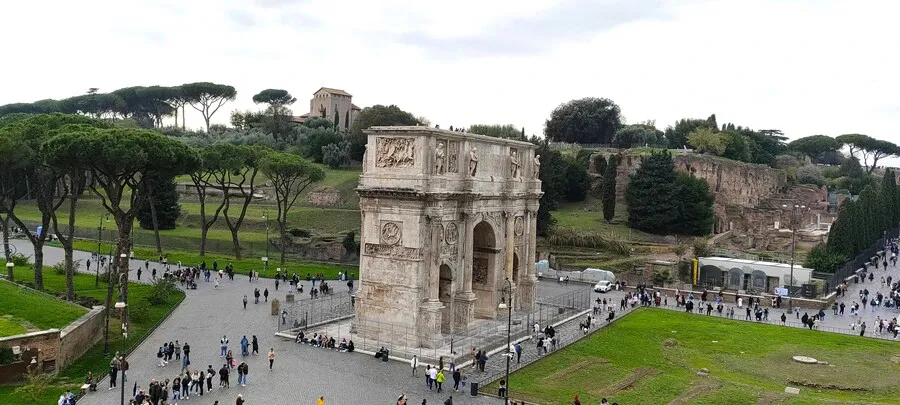
A few steps away, the Via Sacra leads up to the Roman Forum and Palatine Hill. The Arch of Titus stands at the top of this cobblestone ‘sacred way’ just inside the Forum. Dating to 81 AD, the engravings on imperator Titus’ victory arch commemorate Rome’s triumph in the battle of Jerusalem.
Further along, in the north-west corner of the archaeological site, the Arch of Septimius Severus rises above the compendium of ruins which long ago symbolized the heart of the Roman Empire. The white marble arch was erected in 203 AD to honour Emperor Lucius Septimius Severus, a Roman politician born in Libya.
Palatine Hill and The Roman Forum
The Roman Forum and Palatine Hill are opposite the Colosseum and included on the admission tickets. Although it’s only a 3-minute walk along the Via Sacra, there’ll be a lengthy queue waiting outside. Fortunately, there’s an alternative entrance on the adjacent road, Via dei Fori Imperiali, which is a lesser-known and much quicker way to get in. Likewise, the access point near Palatine Hill is quieter (on Via de San Gregorio).
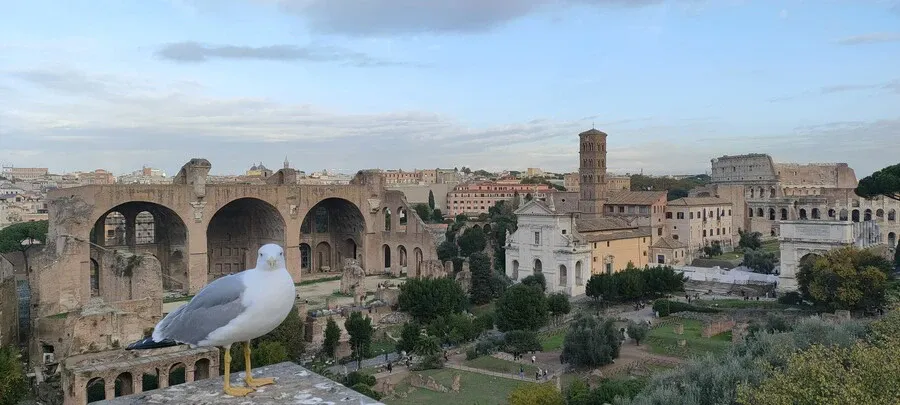
It’s an extensive open-air complex, and a joy to walk around discovering the multitude of ancient sites.
Palatine Hill
Entering the Forum from Piazza Colosseum, we took the left-hand path up to Palatine Hill, where the emperors of Rome built their homes two millennia ago. You can still see the ruins of the palaces where Augustus, Tiberius and Domitian once resided.
The building at the top of the ornamental staircase is known as the Farnese Aviaries. This is a perfect spot to take photos as the Belvedere Terrace is one of the best view points in Rome, with panoramic vistas of the entire Roman Forum.
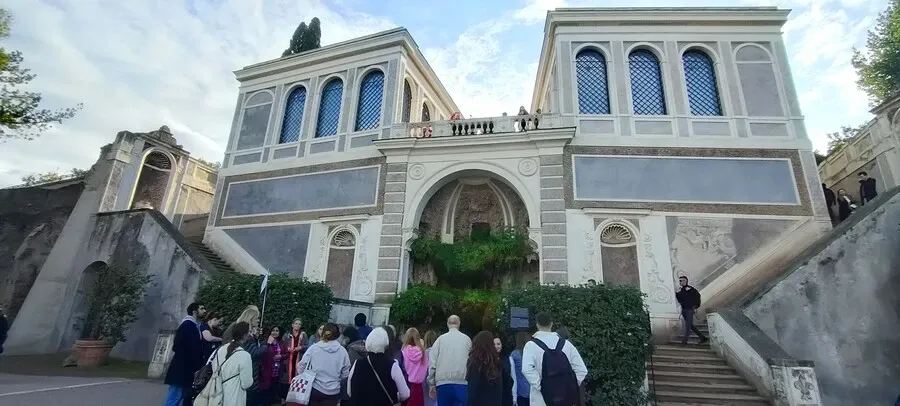
This landmark was part of a 16th century summer house estate built by Cardinal Farnese over the decaying Tiberius Palace. Around the back you’ll find the Horti Farnese Gardens, the first botanical gardens planted in Europe!
An archaeological path traces an itinerary to the western side of Palatine Hill which overlooks the Circus Maximus (which we visited on our 3rd day in Rome).
Roman Forum
The epicentre of the Roman Republic, Forum Romanum started off as a marketplace and grew in importance over the centuries. This is where politicians debated or spoke to the crowds, where courts were held, where the victorious processions ended, where offerings were made in marble temples, where Julius Caesar was murdered and cremated… and when Imperial Rome floundered, the clergy took control and added a number of churches.
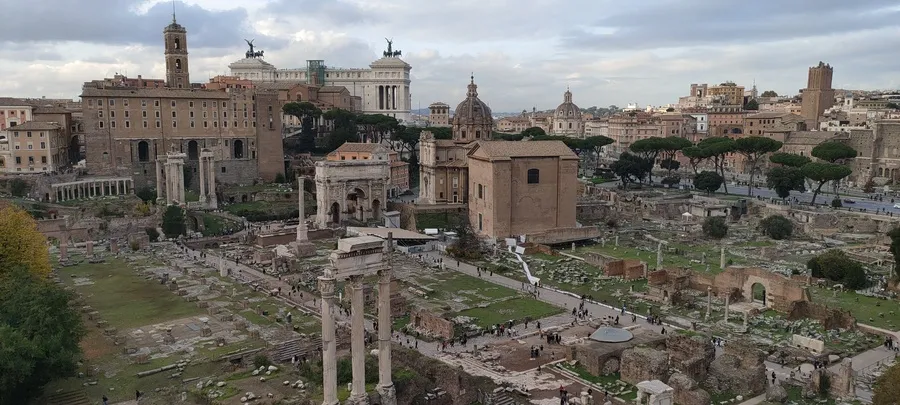
Eventually, the entire area fell into disrepair and remained so until the late 1800s, when excavations and renovations began – a process that continues to this day.
Here are the main points of interest to look out in the Roman Forum:
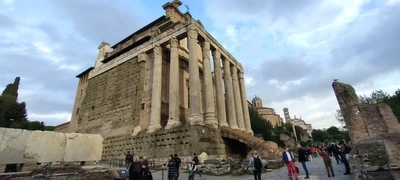
- Via Sacra (main road)
- Arch of Titus
- Temple of Venus and Rome
- Basilica of Maxentius (state hall)
- Basilica of Santi Cosma e Damiano (the round church)
- Temple of Romulus
- Temple of Vesta & House of the Vestal Virgins
- Temple of Antoninus and Faustina
- Temple of Caesar
- Temple of Castor and Pollux
- The Curia (Senate House)
- Arch of Septimius Severus
- Temple of Saturn
When you’ve finished visiting the Colosseum and Roman Forum (takes a good 3 hours), you can catch the underground train to the Vatican (Blue Line to Termini, change to the Orange line for Ottaviano-San Pietro station).
However, you’ll enjoy much more of Rome by strolling through the historical streets of the Centro Storico up to the Spanish Steps, before taking the underground to the Vatican City. Piazza Colosseo to Piazza Spagna is 30 minutes on foot, and it’s a flat itinerary, but you need to factor in stops along the way!
Piazza Venezia
Via dei Fori Imperiali is the road which runs alongside the Roman Forum from the Colosseum to Piazza Venezia at the top of the Roman Forum. This is an intriguing walk with the ruins of the Imperial Fora on either side, much of it still being excavated.
Piazza Venezia is the historical square which looks over the Roman Forum (work is currently going on to extend the subway, so it’s partly cordoned off by barriers).
A great colonnaded marble temple, the Victor Emmanuel II National Monument ‘Altare della Patria’ is one of Rome’s significant landmarks and a national symbol of Italy. Built in the late 1800s to embody the unification of Italy, the equestrian statue of King Victor Emmanuel II stands above the ‘Goddess Roma’ and The Tomb of the Unknown Soldier lit by the eternal flame.
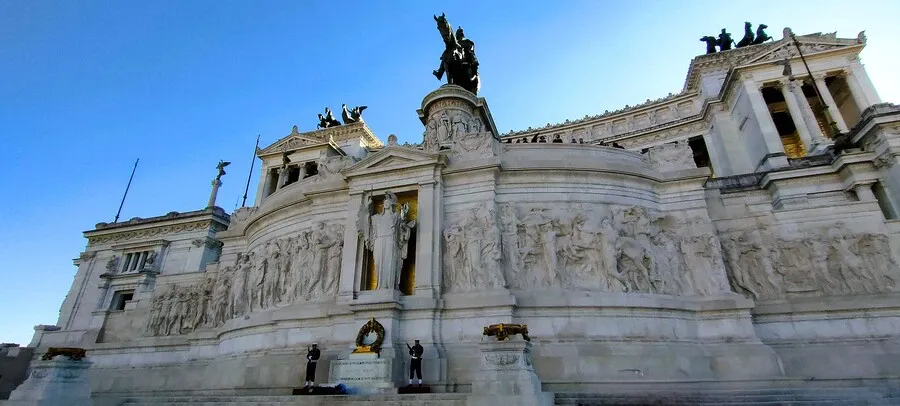
The sculptural neoclassical design continues inside. A lavish marble staircase leads up from the high-ceilinged hall to the ‘terrace of the redeemed cities’ the balcony behind the colonnades which overlooks Piazza Venezia.
Entrance to the national monument is free, although there’s a fee to visit the museum or temporary exhibitions. It costs 10€ to ride the glass elevator up to the rooftop terrace where there are spherical views over Rome.
Historic City Centre
From Piazza Venezia follow Via del Corso, the main street through Rome’s old city centre ‘Centro Storico’, towards Trevi Fountain (sign-posted off to the right).
Campo de Fiori, the Pantheon, Piazza Navona, and numerous worthy sites are located in the maze of alleyways on the left-hand side of Via del Corso towards the river but, if you want to see the Vatican today, there’s not really time to dawdle. Don’t worry, our itinerary loops back to this part of Rome’s historic centre later!
Trevi Fountain

Fontana di Trevi is a must-see site and a top tourist attraction in Rome’s Old Quarter. Hidden away in a backstreet plaza, the monumental 18th-century baroque fountain is definitely worth seeing despite the crowds.
Set against Palazzo Poli, this world-famous water feature is sculpted from Travertine stone. The main figures are the goddesses of Health and Abundance who flank Oceanus on his shell chariot pulled by mythical seahorses, symbolising the ‘Taming of the Waters’.
Fascinatingly, the origins go back even further as the pure waters that feed Trevi fountain flow from the underground aqueducts that have supplied Rome for hundreds of years.
The area around Piazza di Trevi is full of little restaurants but my favourite is Il Bistrot, a modern cafeteria with a bakery. There’s a good choice of salads, pasta, pizzas, pastries and gelatos at a reasonable price. A spacious and popular place where lots of Italians eat, it’s ideal for lunch. The service is pretty quick so you won’t waste precious sightseeing time!
The Spanish Steps
The Spanish Steps are the next stop on our Rome itinerary, a 10 to 15-minute walk from Trevi Fountain.
Although you can cut through the backstreets from Piazza di Trevi to Piazza Spagna using Google Maps on your smartphone, it’s simpler to follow Via del Corso for 500m, then turn right onto Via dei Condotti.
Via dei Condotti is Rome’s elite shopping street where the world’s most exclusive boutiques open their doors by appointment – exquisite window displays by luxury brands like Bvlgari, Dior, and Tiffany catch your attention as you pass by. This historical thoroughfare leads straight to Piazza di Spagna and the Spanish Steps.
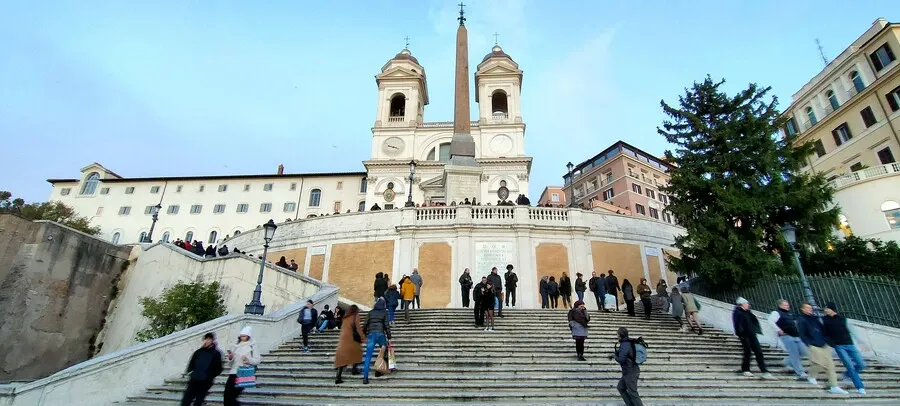
The monumental stone and marble staircase looks like a film set and brings back memories of ‘Roman Holiday’ and ‘Mission Impossible’, a couple of the movies staged here. Built in the 1700s and beautifully restored, it’s a stiff climb up 135 steps to the top of the ‘scalinata’ where Trinità dei Monti church looks down over Rome. Yes, it’s worth going up for the views, and there’s a handy lift beside the Spagna Metro station if you’re not feeling up to it.
From Spagna, take the underground train to Ottaviano-San Pietro for the Vatican (5-minute ride).
Vatican City
Vatican City faces Rome across the Tiber River. The holy walled city-state is famed as the smallest country in the world and a UNESCO World Heritage Centre.
It’s a sacred place for Christianity and home to the Papal Residence, as well as St Peter’s Basilica. The Vatican Museum is another extraordinary attraction. Although the Vatican is a separate country and is protected by the fabled Swiss Guards, it’s just like walking through any other part of Italy as there are no border controls. A separate visa is not required.
Ottaviano-San Pietro is the best Metro station for the Vatican (Line A). Then follow the shopping street for 5 minutes to the high walls of the Vatican Museum – everyone’s heading in the same direction so you can’t go wrong. There are loads of souvenir shops along the way and stalls selling tat (the 1€ fridge magnets are ok and cheaper than central Rome).
Vatican Museums
Now while the Vatican Museums are truly worth seeing, it’s hard to fit this experience into a one-day itinerary without rushing around like a mad thing. Personally, we decided to visit the Apostolic Palace, where the galleries of artwork are housed, on our second day in Rome.
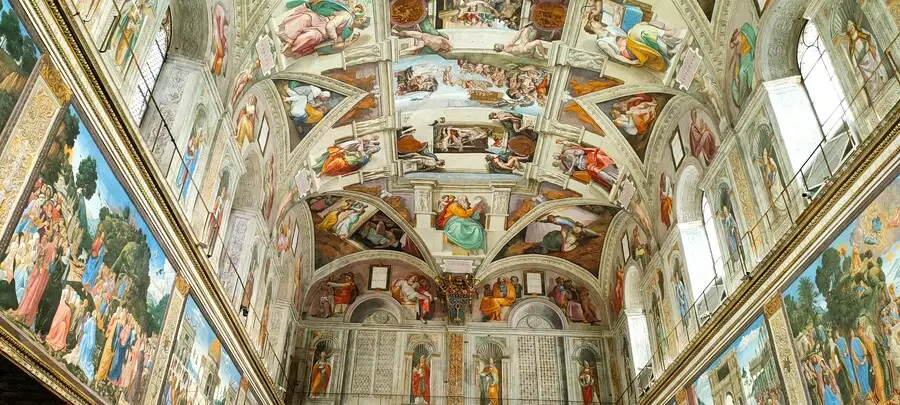
If visiting the Vatican Museums is a priority, you need to plan your day around this. Bear in mind that it takes at least 3 hours to tour this vast museum and there’ll be hoards of visitors. To avoid the huge queues, purchasing a ticket in advance from the official website is essential. A skip-the-line guided tour is the other alternative.
There is a ‘secret passage’ which leads directly from the Sistine Chapel to St. Peter’s Basilica (this way you skip both entrance queues) but only certain VIP tours actually include this shortcut, and these are pricey. This is the Vatican Museums email if you’d like to enquire directly info.musei@scv.va .
Note: You can’t quickly pop into the Vatican Museums just to see the Sistine Chapel. There’s a marked route for visitors to follow which takes you through dozens of exhibition halls and painted galleries before reaching the famous frescoes painted by Michelangelo.
St Peter’s Basilica
Just as I loved seeing the Colosseum, the grandeur and historical significance of Saint Peter’s Basilica left my husband Juan in awe (and he’s a non-practising Catholic!).
St Peter’s Square itself is a HUGE ellipse enclosed by porticoes framing the Basilica at the top. We just walked in, joined the queue, people watched and admired the scene whilst waiting to enter the biggest church in the world.
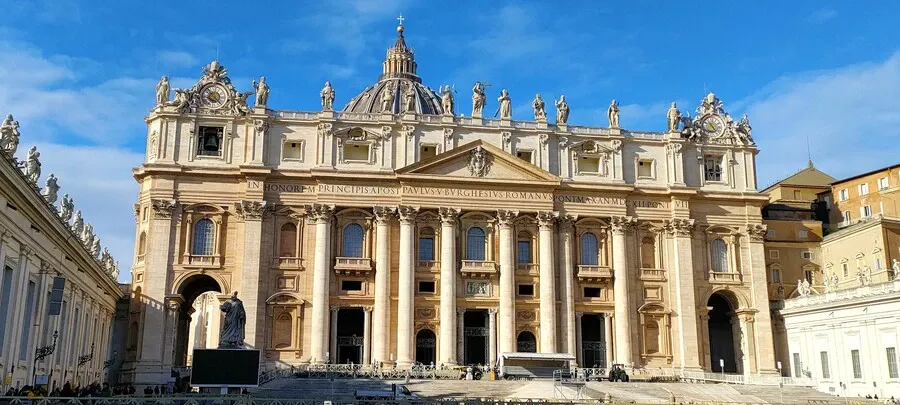
‘Basilica Papale di San Pietro in Vaticano’ is a masterpiece of Renaissance architecture which took 120 years to complete by a succession of Italian Masters under strict Papal guidance (1506-1626). The original plans were drawn up by Donato, Rafael carried on the work, followed by Michaelangelo who designed the magnificent dome, and later Maderno who created the façade with classical Italian Travertine.
St Peter’s bells ring from the squat clock towers on either side of a symmetrical façade supported by 8 Corinthian columns. The Pope’s balcony is the centrepiece. Statues of the apostles line the roof with Christ the Redeemer who stands in front of the highest dome in the world. Large sculptures of St Peter and St Paul take pride of place by the stairs that lead up to the portico.
Visiting the Basilica
Sunlight glitters through stained glass windows to highlight the sacred treasures of the Vatican Basilica. We spent ages looking in awe at the dozens of altars and side chapels, and the hundreds of sculptures, mosaics, and artwork that adorn this hushful place.
Saint Peter’s tomb lies at the heart of the cathedral under the Papal Altar, a focal point of Christian devotion covered by Bernini’s bronze canopy below the almighty dome. Behind this High Altar, at the far end of the nave, you’ll see angels guarding a gilded throne – this is the ‘Altar of the Chair’, which enshrines relics of the saint’s ancient wooden episcopal throne.
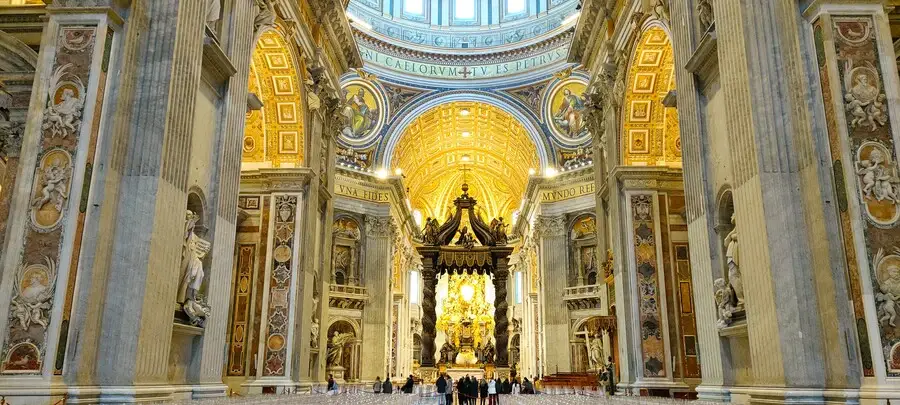
Entrance to the Basilica is free of charge but there’s a fee to go up the dome and to visit the crypt or Treasury Museum (get tickets at the booth).
Early afternoon is a good time to visit St Peter’s while most tourists are still having lunch. If you don’t want to wait in line purchase an audio tour, or book a tour with an authorised guide in advance which gives you priority access at an allotted time).
Open until 6.30 pm (winter), 7pm April to September.
* Remember to dress appropriately or you won’t be let in the Vatican basilica or museums (shoulders and knees must be covered, no skimpy T-shirts or shorts, that includes men).
St Peter’s Square
An Egyptian Obelisk and two fountains mark the centre of Piazza San Pietro while statues of the Holy Saints look down from the curving perimeter of Doric colonnades created by Bernini in Baroque style.
Imagine a setting that holds thousands of pilgrims and well-wishers for the weekly Wednesday Audience when the Pope is at home in the Vatican! In winter, Pope Francis holds audience in the adjacent Papal Hall which is where I saw him.
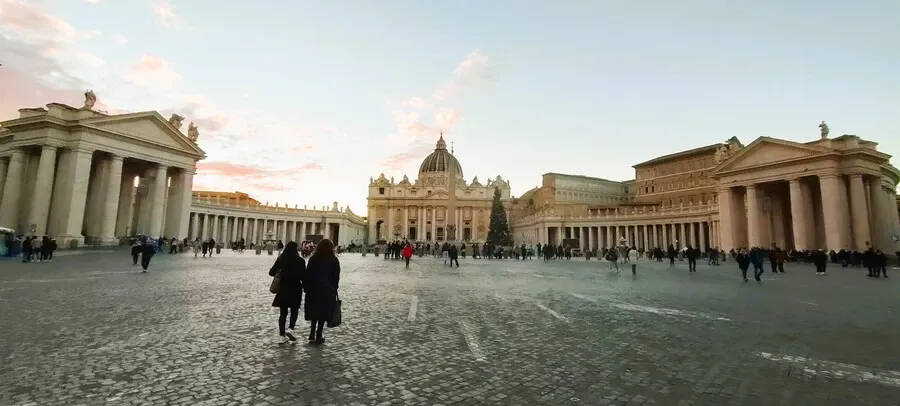
The Vatican Post Office is on the left-hand side of St Peter’s Square (looking up). Sending a postcard with a Vatican stamp is a cool way of immortalizing your trip. The Vatican gift shop is next door with a surprising choice of mementoes, some reasonably priced (the 8€ crystal bracelets are cute). The public toilets are in this strip too.
Via della Conciliazione leads off the Vatican Square. Used as an extension of Piazza San Pietro on mega occasions, the boulevard effectively frames the Basilica and is one of Rome’s iconic scenes. Stretching down to River Tiber a short stroll away, this avenue serves as a grand promenade flanked by Palazzos housing embassies and upscale cafés.
Castel Sant’Angelo
Just outside of the Vatican City, Castle of the Holy Angel was originally conceived in 138 as a mausoleum, the final resting place for Hadrian (a Roman Emperor born in Seville).
Once the highest building in Rome, it’s easy to spot the massive rotonda by the riverside as you walk down from St Peter’s Square. In fact, Hadrian’s Mole commands such a good position on the righthand bank of the Tiber, that the Vatican claimed it as a castle.
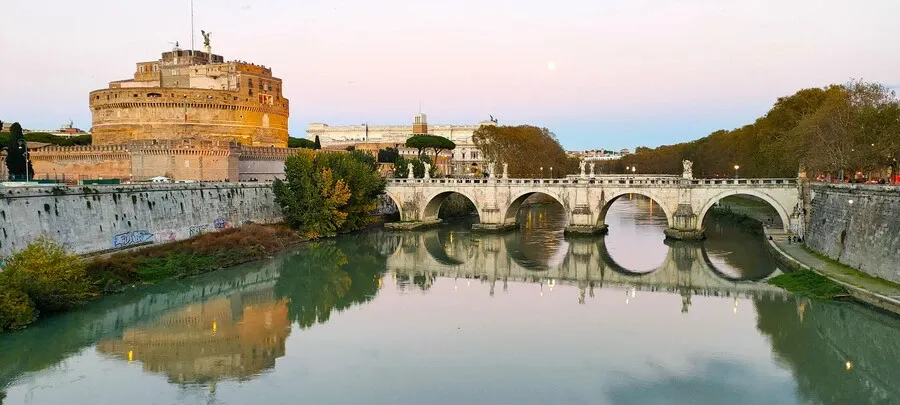
Like all castles this one has a legend… according to folklore, an angel appeared on the roof after vanquishing the deadly pandemic which swept through Rome in 590.
Another magnet for tourists (entrance includes a tour of the history museum inside and panoramic viewpoints from the top), it was late afternoon and crowded, so I took photos of Castel Sant’Angelo from the river bridge but left the visit for another day.
St Angelo Bridge
Ponte Sant’Angelo is the monumental 5-arch marble pedestrian bridge that crosses the Tiber River from Castel Sant’Angelo over to Rome’s Centro Storico. Once the Pilgrim’s way to the Vatican, statues of St Peter and St Paul along with the 4 Evangelists guard the balustrade, while Archangel Michael watches down from the top of the Castel.
This is one of the most beautiful places in Rome to capture the sunset, with the angels of St Angelo’s bridge against a backdrop of the castle and the dome of St Peter’s Basilica on the skyline.
From here it’s a 30-minute walk back to Trevi Fountain (if you’re using this as a reference) via Piazza Navona and the Pantheon, popular sites in Rome’s Old Quarter which you can squeeze into the day or evening.
Centro Storico di Roma
To recap, Centro Storico’s top attractions are the Colosseum, Roman Forum and Palatine Hill, Altar of the Fatherland, Trevi Fountain, the Spanish Steps, Piazza Navona and the Pantheon.
Assuming you’re following my 1-day itinerary, after leaving the Vatican it may still be daylight when you head back to the old town on the east bank of the Tiber (sunset is around 8.30 pm in summer). And although it gets dark around 5 pm in winter, this doesn’t really matter as the Centro Storico has a magical atmosphere at twilight.
Piazza Navona
Wandering along the side streets you’ll come to Piazza Navona an elongated public square full of Baroque splendour – the façades of Sant’Agnese in Agone Basilica and 17th-century palazzi surround this atmospheric place which features an Egyptian Obelisk and two sculptural fountains (the Fountain of 4 Rivers and the Fountain of Neptune).
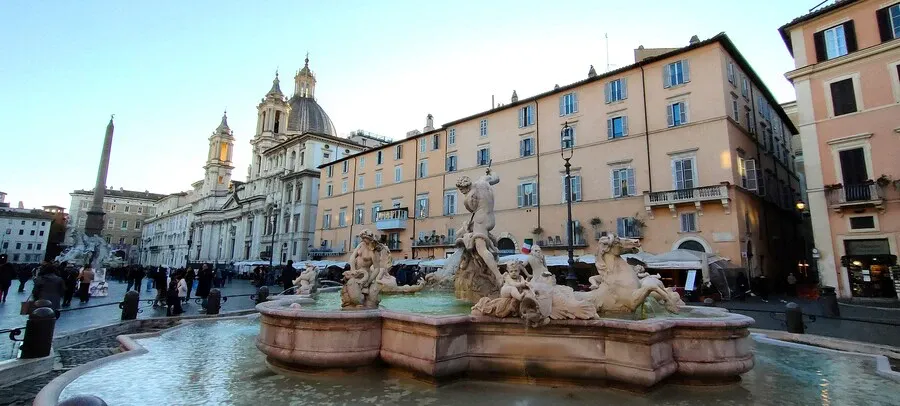
Built over ruins of the Stadium of Domitian, where Roman athletes competed 2 millennia ago, Piazza Navona was Rome’s central marketplace in the Middle Ages before it was remodelled by the artistic elite.
Come evening the ambience is still lively as it’s an atmospheric place to dine. There are several classic osterias, ristorantes with terrace tables and pizzerias in the square and adjacent streets.
Rome Pantheon
Two blocks away from Piazza Navona (turn west by Neptune’s Fountain) you’ll find another gem hidden in the backstreets, the Pantheon. A legacy from ancient Rome, the sturdy circular building has survived nearly 2 thousand centuries of Italian history, and it’s still intact! Set in Piazza della Rotonda, facing the fountain and obelisk, you can’t really miss it.
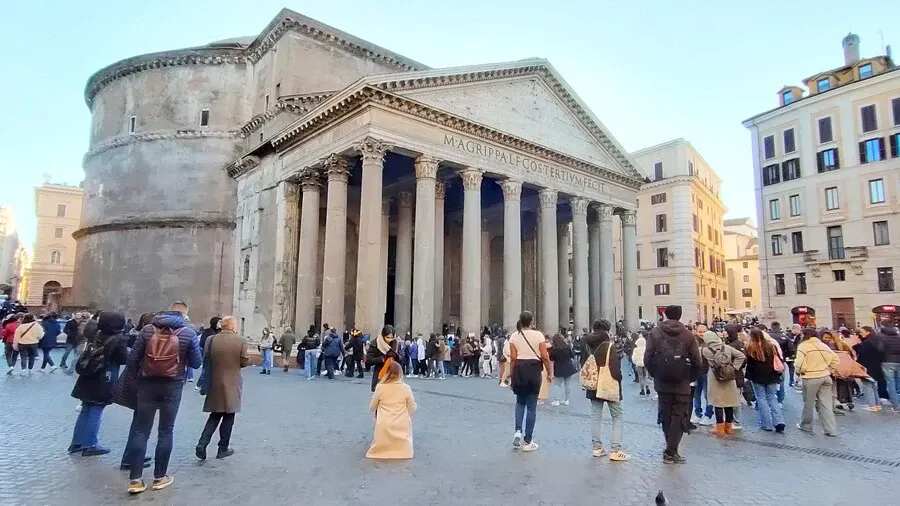
While other city monuments were damaged, neglected or razed and eventually built over, after the decline of the Empire, this Roman temple is still standing and continues to be used as a place of worship today (albeit converted into the Catholic Basilica of St. Mary and the Martyrs in 609 AD). The exterior looks rather plain until you get to the front entrance which resembles a temple-style colonnaded portico.
The remains of the Christian Martyrs (brought from the Catacombs which we visited on day 3 of our Rome itinerary) lie at rest inside the high-ceilinged domed interior. Rafael the Renaissance architect is entombed here too. He was greatly impressed by the Pantheon’s unique design – sunlight coming through the Oculus (circular hole at the top of the coffered dome) illuminates the huge circular hall below to create an ethereal effect.
While churches in Rome and the Vatican are generally free to enter (including St Peter’s Basilica), the Pantheon has recently started to charge a nominal 5€ fee to control the increasing number of tourists turning up each day.
Open until 6.30 pm daily (last entry), you can purchase tickets at the door although it’s best to book a timed slot online in advance from the official ‘Italian Museums’ site to save queuing if you’re only in Rome for a day.
You’re now only 5 minutes away from the Trevi fountain. There aren’t any metro lines under the Centro Storico so the nearest station is a 10-minute walk up to Piazza Barberini. The quickest way to do this is to use Google Maps which guides you through the back streets and up the last drag to Barberini Square where you’ll see the Triton Fountain. It’s only 2 stops on the orange Line A from Barberini to Roma Termini.
Related Posts: Popular City Itineraries in Italy
Whether you’re here at the weekend, or just love travelling and need to budget the frills, our ‘1 Day in Florence’ guide gives some useful suggestions for a day out or overnight stay in Italy’s favourite city.
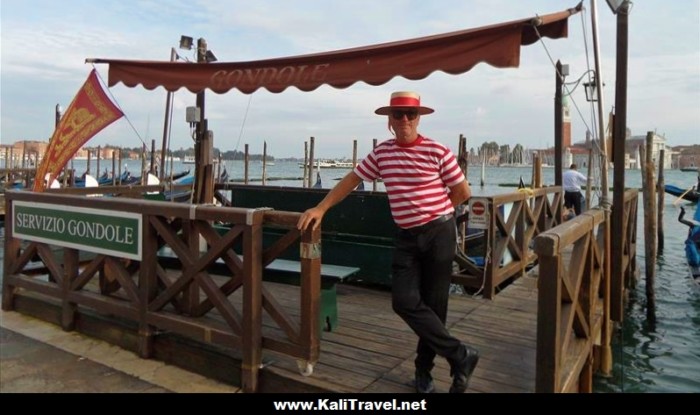
Venice is one of the best places to visit in Italy, a unique and thrilling experience! Stay in the heart of old Venice city, discover the iconic sites and then wander along the maze of canals away from the tourist scene.
This post explains why Pisa is worth visiting, with all the info you need to know about the top sites and how simple it is to get here. Fit Pisa into your travel plans for a few hours or a longer stay!
1 day in Siena, Italy: How to see Siena in a day with our easy self-guided walking itinerary. Discover the medieval sites of Tuscany’s famous hilltop city.
The Medieval Walled City of Lucca
Our comprehensive guide explains everything you need to know about Lucca, Italy. Follow our 1 day itinerary or gather ideas for a holiday in Tuscany’s beautiful walled city.
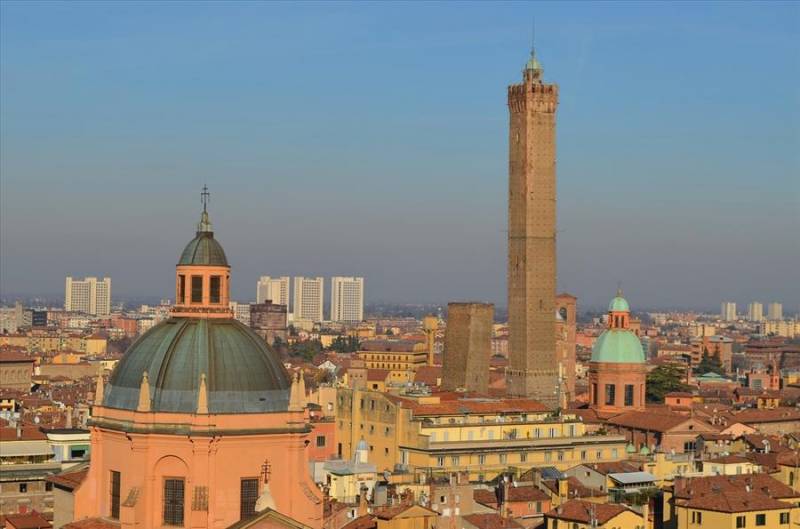
If you want a totally Italian experience that includes World Heritage Sites, and incredibly good food and wines, then start your holiday with 2 days in Bologna (or fly over for the weekend).
A 3 day Cinque Terre itinerary explaining how to see the 5 villages of Monterosso, Manarola, Corniglia, Vernazza & Riomaggiore, the beaches, walks and cuisine.
Discover the World with![]() the blog with a focus on independent travel
the blog with a focus on independent travel




